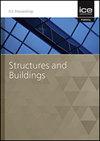考虑高温和剥落效应的RC梁热力学性能研究
IF 1.4
4区 工程技术
Q3 CONSTRUCTION & BUILDING TECHNOLOGY
Proceedings of the Institution of Civil Engineers-Structures and Buildings
Pub Date : 2022-08-12
DOI:10.1680/jstbu.21.00201
引用次数: 1
摘要
为了研究高温对RC梁热力学性能的影响,对4根全尺寸简支梁进行了火灾和力学试验。建立了基于实测信息的数值分析模型,并通过实验测试和理论计算对模型进行了验证。进一步分析了火灾暴露时间、不同物理参数和混凝土剥落参数对混凝土热力学性能的影响。结果表明,随着火灾暴露时间的增加,测得的振动频率呈波动衰减趋势。模拟频率随火灾暴露时间的幂函数而衰减。频率随跨高比的增大而减小,随截面宽度、混凝土弹性模量和配筋率的增大而增大。截面温度场受剥落深度的影响最为显著,随剥落深度的增加而迅速增大。随着剥落面积比的增大,温度场的增幅逐渐变小。剥落面积比大于15%后效果相对稳定。随着剥落深度的增加,抗弯承载力呈线性下降趋势。随着剥落面积比的增大,剥落面积比呈幂函数递减趋势。本文章由计算机程序翻译,如有差异,请以英文原文为准。
Study on thermodynamic properties of RC beams considering elevated temperature and spalling effect
In order to study the effect of high temperatures on the thermomechanical properties of RC beams, fire and mechanical tests were carried out on four fully-dimensioned simply supported beams. A numerical analysis model based on the measured information was developed, and it was validated through experimental tests and theoretical calculations. The effects of fire exposure time, different physical parameters and concrete spalling parameters on the thermodynamic properties were further analyzed. The results show that the measured vibration frequencies appear a fluctuating trend of decay with increasing fire exposure time. The simulated frequency decays as a power function of fire exposure time. The frequency decreases with increasing span-to-height ratio and increases with section width, elasticity modulus of concrete and reinforcement ratio, respectively. Cross-sectional temperature field is most significantly affected by spalling depth, which increases rapidly with its increasing. With the increase in spalling area ratio, the increase in the temperature field gradually becomes smaller. The effect of spalling area ratio was relatively stable after more than 15%. The flexural bearing capacity shows a linear decrease trend with the increase in spalling depth. With the increase in spalling area ratio, it shows a power function of the decreasing trend.
求助全文
通过发布文献求助,成功后即可免费获取论文全文。
去求助
来源期刊
CiteScore
3.40
自引率
6.20%
发文量
61
审稿时长
12 months
期刊介绍:
Structures and Buildings publishes peer-reviewed papers on the design and construction of civil engineering structures and the applied research associated with such activities. Topics include the design, strength, durability and behaviour of structural components and systems.
Topics covered: energy conservation, people movement within and around buildings, strength and durability of steel and concrete structural components, and the behaviour of building and bridge components and systems

 求助内容:
求助内容: 应助结果提醒方式:
应助结果提醒方式:


